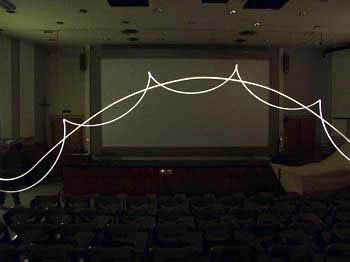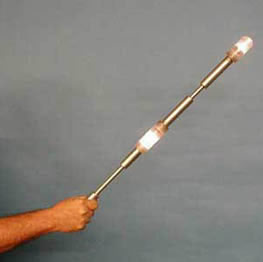Demos: 1D-11 Trajectory of the Center of Mass

 A metal bar having lights on one end and at at the middle is tossed end over end toward a sheet trap. The bar is photographed and the light paths show a smooth, parabolic trajectory for the bulb attached at the CM, whereas the path of the other bulb is “cycloidal.”
A metal bar having lights on one end and at at the middle is tossed end over end toward a sheet trap. The bar is photographed and the light paths show a smooth, parabolic trajectory for the bulb attached at the CM, whereas the path of the other bulb is “cycloidal.”
Directions:The bar is partially made of Lucite (at the center) and has two built-in light bulbs and batteries. One bulb is at the end of the bar whereas the other is at the center of gravity. First, the two bulbs have to be screwed in to light them (the center section has to be separated). The wand is then tossed through the air in such a way as to have it rotate about its CG a few times. The bar lands in a “hammock” to avoid damage.
Suggestions for Presentation: Point out that the CG is the location on an object that behaves as a “point particle.” That is, when tossed through the air, this part of the object traces out a parabolic trajectory. Have the students follow this point as the bar is thrown. Then throw it again and have them concentrate on the end. A time lapse photograph of this motion has been taken previously and the negative is available for projection on the overhead. It shows clearly both the parabolic trajectory and the looping motion of the end piece.
Applications: Any complicated motion in which the various parts of the object can be tracked. The CG always follow the point particle path. For example, it is shown that the “smoothest” place to ride in a bus is near its center, because the CG follows a fairly smooth path whereas the other parts are more likely to behave erratically.
Last Updated: Nov 30, 2023 11:25 AM